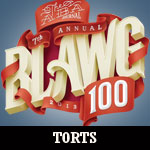20 Years Ago This Week: The Stella Liebeck McDonald’s Hot Coffee Trial
As we noted last Friday, August 2014 heralds the twentieth anniversary of one of the most famous civil cases in American history: the Stella Liebeck McDonald’s hot coffee case. Tried on August 8-12 and 15-17, 1994 in New Mexico state court, the case produced a verdict that has continued to reverberate throughout our culture. (Reminder: Liebeck was awarded $200,000 in compensatory damages, a number which was reduced to $160,000 as a result of a patrial contributory negligence finding by the jury. She was also awarded $2.7 million in punitive damages, a figure which was later reduced to $480,000 by the court.). As we have noted in the past, the case settled prior to the issuance of a formal appellate court opinion, and thus, there is no helpful formal account of the matter’s factual and procedural history. This has led to some confusion surrounding the facts, which we’ve attempted to remedy by publishing our Stella Liebeck McDonald’s Hot Coffee Case FAQ. This week, in observance of the trial’s 20th anniversary, we will explore the case in a bit more detail than usual and offer some critical thoughts that go beyond the traditional rhetoric.
Why do so? As the years have passed, the conventional wisdom about the case has begun to shift. For the longest time, the story represented the tale of a negligent consumer who received a large verdict from a sympathetic jury despite her clear contributory negligence. Now, however, a new narrative has emerged. There is now a group that believes that the uproar over the verdict was the result of a nefarious corporate strategy to misrepresent the true underlying facts of the case in an effort promote tort reform. This new line of thinking gained traction with the 2011 release of Susan Saladoff’s editorial documentary, “Hot Coffee.”
Not too long ago, we noticed that one of our favorite blogs, the popular and influential Boing Boing, revisited the McDonald’s hot coffee lawsuit. In that post, author Cory Doctorow, in introducing a linked piece by Alex Mayyasi of Priceonomics, noted as follows: “Remember the old lady who sued McDonald’s for millions because she burned herself by spilling hot coffee in her lap? It never happened. What actually happened was much more sordid, and the deliberate distortion of the story — which is ultimately about a company that caused repeated, horrific and preventable injury to its customers — is a tidy story about how corporations have convinced us that they are victims of out-of-control tort lawyers.” In his article, Mayyasi argues that the verdict led to efforts to erode the Seventh Amendment right to a jury trial. Countering the argument that the case is an example of the need for tort reform, Mayyashi contends that the traditional understanding of the Liebeck case is “incredibly distorted.,” as Liebeck herself “was not greedy and her lawsuit was not frivolous.” He goes so far to conclude that the Liebeck case is “an example of America’s civil justice system working as intended.”
In his piece, Mayyasi relies a good bit on Saladoff, a former plaintiff’s attorney about whom we have previously written here. In so doing, Mayyashi shares Saladoff’s belief that “frivolous lawsuits” are a “myth.” (Were that truly the case, we’d have little to discuss here at Abnormal Use.). To his credit, Mayyasi identifies Saladoff as a “former trial lawyer” who has “represented clients in liability lawsuits” and suggests later in the article that “as a trial lawyer . . . [she] is not an objective outsider but someone building a case for her side.” (Many media outlets, in reviewing or reporting on “Hot Coffee,” neglected to mention Saladoff’s history.). Further, despite Doctorow’s tough introduction to the piece, Mayyasi concedes several points, including the fact that “[c]offee is often served commercially at temperatures approaching or equal to that served to Stella Liebeck; finding Liebeck 80% or 100% responsible may be reasonable.” He also indicates that the McDonald’s representatives’ purported lack of concern about the alleged 700 complaints of hot beverage related incidents “may have seen reasonable given the scale of McDonald’s operation.” Those are some significant statements in a piece dedicated to Liebeck case and the purported erosion of the right to a jury trial.
Here’s how Mayyasi’s described the facts of the Liebeck case:
After Ms. Liebeck bought her coffee and breakfast, her grandson, who was driving, pulled over so she could add cream and sugar to her coffee. Since his Ford Probe had no cup holders, she placed the cup between her legs. When she fumbled with the lid and spilled the coffee on her sweatpants, she began to scream.
….
She went into shock and her grandson rushed her to the emergency room, where she would undergo surgery and receive skin grafts. She had third degree burns on 6% of her body; the pictures of her injuries are shocking.
It is the gruesome photographs of Ms. Liebeck’s injuries – recently receiving prominence in Saladoff’s documentary – which have convinced many that Ms. Liebeck’s case must have had some merit. Despite the severity of her injuries, Liebeck elected to place the cup of coffee – with its warning “contents hot” emblazoned thereupon – precariously between her legs in attempt to open it and place her cream and sugar therein. How is it a distortion to recite those facts and argue that Liebeck’s contributory negligence should have barred her recovery outright? Can one not argue that the jury got it wrong, or that the defense should have presented a better case with the facts as known? (Interestingly, it is not entirely correct to say that “[Liebeck’s] grandson rushed her to the emergency room.” Rather, her grandson, Chris Tiano, testified at the trial that after the spill he traveled to the Albuquerque Country Club to pick up a paycheck before taking his grandmother to the hospital.).
This week, we’ll explore these issues fully and even offer some interesting trivia about the case and even some of the witnesses. We hope you’ll offer your own thoughts on the case, as well.

















